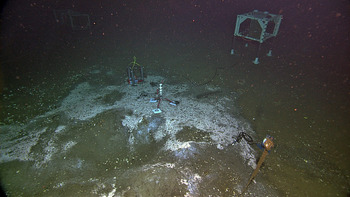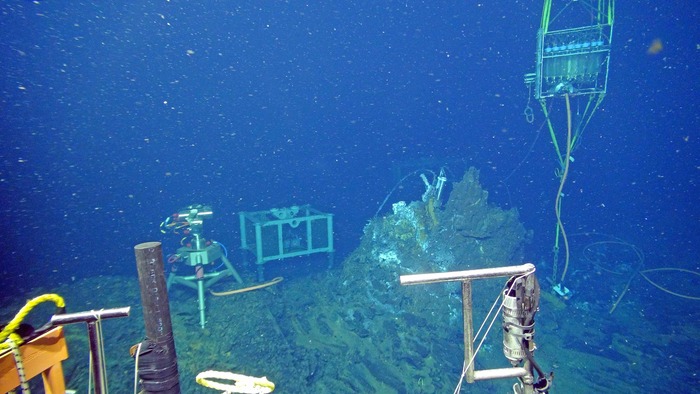
An in situ, cabled mass spectrometer is installed at a methane seep at the summif to Southern Hydrate Ridge. The OOI-RSN mass spectrometer was built by Peter Girguis, Harvard University. The intake host is on a small tripod and the mass spectrometer is housed inside a titanium housing within a half-size junction box frame. It is installed adjacent to an instrument to measure fluid flow in and out of the seafloor (Mosquito) and an osmo fluid sampler for seep chemistry. Photo credit: NSF-OOI/UW/CSSF; Dive R1772; V14.
Measurements of dissolved gas concentrations such as carbon dioxide, methane, and hydrogen sulfide are critical to understanding volcanic, chemical, and biological processes in submarine environments. Carbon dioxide in magma chambers helps drive seafloor eruptions, and, along with methane and hydrogen sulfide, is key to supporting the subseafloor biosphere. Until recently, however, it has been impossible for scientists to measure these gases in situ for long-periods of time. Scientists depended on taking individual samples from vents and seeps, and then analyzing them back in land-based laboratories.
Two novel mass spectrometers, developed by Peter Girguis at Harvard University, are installed on the Cabled Array, providing real-time measurements of gases with live transmission of the data to shore. One mass spec was installed in the diffuse vent site called El Gordo from 2014-2017 in the International District hydrothermal vent field at the summit of Axial Seamount. During the summer of 2017, it was moved to the Tiny Village site, also in the International District. A second mass spectrometer has been deployed at Southern Hydrate Ridge since 2014.


